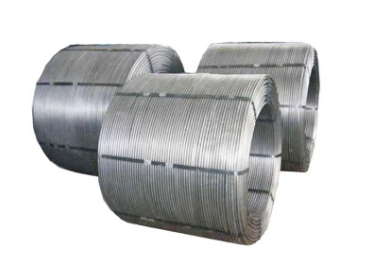
Calcium cored wire is a crucial component in the steelmaking industry, employed in various refining processes to enhance the quality and performance of steel. Understanding the specifications of calcium cored wire is essential for steel manufacturers to select the appropriate wire for their specific applications. In this article, we explore the key specifications of calcium cored wire, shedding light on its size, composition, packaging, and other relevant factors.
Calcium cored wire is available in different sizes, typically ranging from 9mm to 16mm in diameter. The wire size is a critical specification as it determines the amount of calcium released into the molten steel. Larger wire sizes offer higher calcium yield, making them suitable for applications requiring significant calcium addition. Conversely, smaller wire sizes are utilized when precise dosing and controlled release of calcium are desired.
The composition of calcium cored wire is another crucial specification. The wire typically consists of a steel sheath surrounding a calcium-based powder core. The calcium content within the core can vary depending on the desired application. Common compositions include calcium-silicon (CaSi) and calcium-aluminum (CaAl) alloys. The composition directly influences the wire's effectiveness in desulfurization, deoxidation, inclusion modification, and alloying processes.
Packaging specifications are essential to ensure the wire's integrity during storage and transportation. Calcium cored wire is often packaged in coils or spools to prevent damage and tangling. The packaging material should provide adequate protection against moisture and other environmental factors that may degrade the wire's quality. Additionally, clear labeling indicating wire size, composition, and manufacturer details facilitates easy identification and handling.
The length of calcium cored wire is an important consideration in steelmaking operations. The wire length can vary based on the manufacturer and customer requirements, typically ranging from 2 meters to 5 meters. The appropriate wire length ensures efficient and convenient usage during the steelmaking process, allowing for easy feeding into the ladle or other equipment.
Calcium cored wire specifications also encompass the design and compatibility of handling and feeding systems. These systems are employed to introduce the wire into the molten steel. Different equipment configurations, such as wire feeders or injection systems, are utilized based on the wire size, composition, and specific steelmaking requirements. The seamless integration of calcium cored wire with the feeding system ensures accurate and controlled delivery of calcium into the steel melt.

Quality assurance specifications are crucial in selecting a reliable calcium cored wire supplier. Reputable manufacturers adhere to international standards and possess certifications such as ISO 9001, ensuring consistent product quality and performance. Compliance with quality standards guarantees that the wire meets the required specifications, enabling steel manufacturers to achieve desired steel quality and performance consistently.
Understanding the specifications of calcium cored wire is vital for steel manufacturers to optimize their steelmaking processes. Wire size, composition, packaging, length, handling systems, and quality assurance are key specifications to consider. By selecting the appropriate calcium cored wire based on these specifications, steel manufacturers can enhance desulfurization, deoxidation, inclusion modification, and alloying processes, ultimately producing high-quality steel with superior mechanical properties and performance.

Write a Message